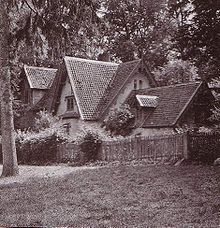Niedermühle (Hundisburg)
The Niedermühle is a listed former mill in the Hundisburg district of the city of Haldensleben in Saxony-Anhalt . In the local register of monuments , the building is registered as a monument under registration number 094 50047 .
location
The building stands on the forest path to the northwest below the Hundisburger Schlosshügel in the Beberaue on the Mühlgraben, which drains into the Beber flowing 80 meters away . The mill ditch was created in the Middle Ages and served to collect the slope water and drain the floodplain. Following the forest path you will find the listed Hundisburger Zechenhaus about 100 meters away and after 400 meters the Hundisburger Forsthaus, which is also listed .
history
The building used today as a residential building is a former mill. At least since the beginning of the 17th century there has been a water-powered flour mill at this point. This mill is mentioned in a deed from 1609. Around 1814 Johann Gottlob Nathusius had a pre-industrial factory building with a smelter , iron foundry and a water-powered copper hammer built in its place , which was later converted into an iron foundry for furnace plates . This factory building was presumably much larger than the structure present here today and is likely to have resembled the colliery that was built around the same time.
After the end of the industrial era in Hundisburg, the factory was demolished and a new grain mill was built around 1843 under Hermann von Nathusius . As early as May 21, 1836, the Neuhaldensleber Wochenblatt announced that Nathusius intended to build an oil mill with two aisles instead of the building previously used as a copper hammer . However, this plan was not implemented. Instead, in the new building in 1843, a grain mill with two grinding courses for flour and meal was installed. The grinding mills were driven by a shaft that was driven by an upper or middle shaft water wheel. In 1881 Joachim von Nathusius also had a circular saw installed. In 1891 the roller systems were replaced, three grinding and one grist pass were installed. The mill was probably stopped in the 1920s. In 1921, the building was converted into a farm workers' accommodation in its present form. In 1997, the Nathusius family acquired the building again and renovated it. A bridge over the Mühlgraben was demolished during the renovation. The Niedermühle is now used as a residential building.
The building is one of the striking focal points in the Althaldensleben-Hundisburg landscape park . The great aesthetic appeal of the mill in connection with the importance of the landscaped park planned by Johann Gottlob Nathusius as well as the particularly striking design in the English cottage or country house style (especially for a functional building) lead to the monument status.
architecture
The cottage-style building ensemble consists of three building parts built into one another with different ridge and eaves heights . They are made of quarry stone and have steep gable roofs and half-timbered dormers . The tallest building is the actual mill directly on the Beber bay with a concise elevator . Today there is a Gothic-style window on the courtyard side and a gable window on this part of the building. The water wheel was located on the gable side and was roofed, it was accessible through a gate from the mill room. The middle part of the building was the miller's house. It has a wide transverse gable, a porch and large windows. The adjoining former stable is the lowest of the three building elements; it has bay windows on both sides of the eaves . The masonry was plastered down to the base, the window frames painted natural or dark. The roofs were covered with brim tiles, the roofs and verges were made of slate . The verge leaves were artfully cut.
Web links
Remarks
- ↑ Originally the Mühlbach was derived from the Beber and fed back to the Beber after passing through the mill wheel. Today the Mühlbach feeds itself only from well and groundwater.
Individual evidence
- ↑ a b c d List of monuments of the State Office for Monument Preservation and Archeology Saxony-Anhalt , May 22, 2017, page 726, Haldensleben-Hundisburg, registration number: 094 50047, date of registration: March 1, 2000
- ↑ a b Nadine Becker, Dorit Börner and Fred Tomke, Hundisburg Landscape Park - a contribution to maintenance and development planning: vegetation studies of the meadow areas in the Althaldensleben-Hundisburg park , project work at the Anhalt University of Applied Sciences , Bensburg 1999, p. 8 u. 31f
- ^ Siegmund Wilhelm Wohlbrück , Geschichtliche Nachrichten von dem Geschlechte von Alvensleben and its goods , Volume 2, 1819, p. 276
- ↑ a b c d e Ulrich Hauer : Of art gardeners and garden art. The gardeners and gardens of the Nathusius family in Althaldensleben and Hundisburg , KULTUR-Landschaft Haldensleben-Hundisburg eV and Museum Haldensleben (ed.), Haldensleben-Hundisburg 2005, DNB 978432916 , pp. 40, 47, 82, 87 and 90
- ^ Franz Bosbach , Landscape Gardens of the 18th and 19th Centuries: Examples of German-British Cultural Transfers , Walter de Gruyter , 2008, ISBN 978-3-598-44122-6 , p. 27
- ^ Biedermeier in Haldensleben: Landscape Park , website of the Ecomusées Haldensleben-Hundisburg
Coordinates: 52 ° 15 '6.2 " N , 11 ° 23" 59.1 " E

